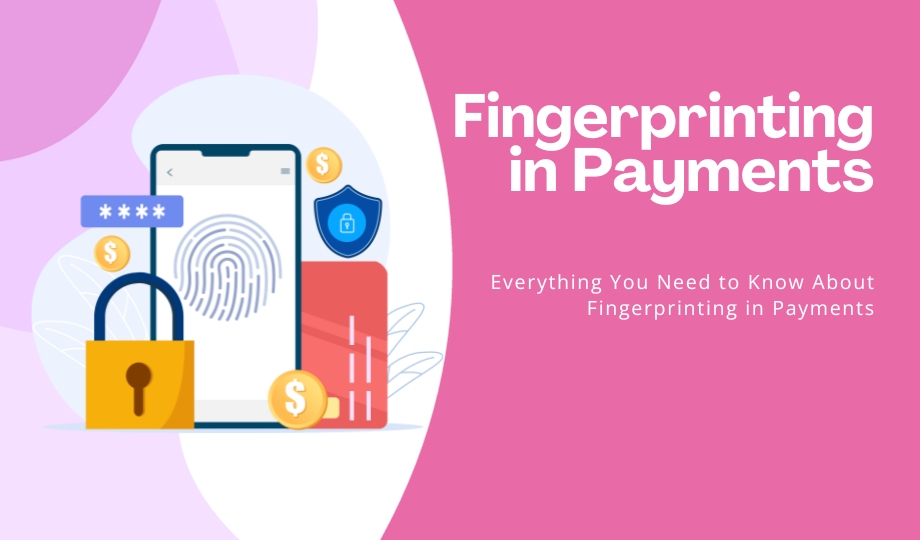Payment fingerprinting serves as a crucial method for businesses to discern and deter fraudulent activities involving one or more users employing the same payment methods. For online merchants and business owners, integrating fingerprinting into their technology stack is essential. This blog elucidates the concept of fingerprinting, how it operates, its merits, and how merchants can seamlessly incorporate fingerprinting into their tech arsenal.
What is Fingerprinting?
Fingerprinting, or device fingerprinting, entails the process of associating a unique identifier with the device used by a user to browse a website or utilize an application. Device fingerprinting services assign this identifier based on a spectrum of attributes, including HTTP request headers, IP addresses, installed plugins, user-agent strings, timestamps, installed fonts, Silverlight data, client time zones, and mime-types. Once the fingerprint is established, businesses can thwart fraud and gain insights into users’ online activities, enabling them to tailor their approach. Think of fingerprinting as a robust, more dependable substitute for cookies.
Fingerprinting goes beyond capturing device information; with the right service provider like Web Technology Expert, it allows businesses to identify the payment methods used by users, assigning a unique fingerprint to each one to avert fraud. This aids merchants in accurately tracking payment flows, detecting any fraudulent activity, and ensuring the security of their business and customers. Now, let’s delve into how payment method fingerprinting operates.
How Does Payment Method Fingerprinting Work?
To elucidate how payment fingerprinting functions, consider this illustration: A customer adds a product to their cart and proceeds to make a purchase. During checkout, an order ID is generated, and the customer is presented with payment options, such as UPI, credit/debit cards, digital wallets, and bank transfers (for this example, let’s focus on UPI). The customer enters their UPI ID, and upon payment confirmation, the payment provider communicates with the merchant. The payment method fingerprinting service provider captures the customer’s chosen method and generates a unique fingerprint associated with that UPI ID. Merchants can then employ this unique fingerprint to query customers. If multiple customers yield the same fingerprint in their responses, it signifies the use of the same UPI ID for payments by several users, potentially indicative of fraudulent activity. This enables merchants to identify and mitigate illicit fraud incidents.
Use Cases for Fingerprinting
Fingerprinting predominantly serves two critical purposes:
1. Tracking and Targeting Visitors
Device fingerprinting empowers businesses to monitor and target website visitors effectively. By tracking unique and returning visitors, businesses can craft precise user profiles based on behavior, IP addresses, and time zone settings. This enables businesses to execute personalized ad campaigns, ultimately enhancing conversions.
2. Fraud Prevention
Many companies rely on fingerprinting to prevent fraud, particularly evident in online gaming companies. In online gaming, identity theft and other forms of fraud are rampant, with users creating multiple profiles to disrupt gameplay and steal money, in-game currency, and payment information. Fingerprinting allows gaming companies to identify users who have created multiple profiles but are using the same payment method. By searching for the fingerprint ID in their user database, companies can spot such users and take appropriate actions, such as banning them, ensuring a seamless gaming experience for legitimate players.
Benefits of Fingerprinting
- Here are the key benefits of fingerprinting:
1. Combatting Gaming Payment Fraud
Online gaming often witnesses users creating multiple profiles to gain unfair advantages over others. Fingerprinting helps businesses identify if multiple gamers are using the same payment method, enabling companies to ban fraudulent users, thereby preserving fair play.
2. Mitigating Card Testing Frauds
Fraudsters often attempt numerous credit cards to find one that works. With device fingerprinting, merchants can easily identify which device and associated account conducted multiple declined transactions, enabling swift action.
3. Preventing Account Takeover (ATO)
Account Takeover (ATO) is a prevalent attack wherein cybercriminals steal usernames and passwords to access legitimate user accounts. Fingerprinting assigns a unique fingerprint to the device used for login, facilitating the detection of ATO incidents.
4. Reducing Manual Checks
Automation of fraud detection through fingerprinting minimizes the need for time-consuming manual checks, enhancing security, reducing errors, and ensuring safety.
How Can Web Technology Expert Help?
Web Technology Expert is a payment aggregation and unification platform that simplifies the incorporation of payment fingerprinting into your tech stack. Merchants can use Web Technology Expert to collect users’ payment methods and assign unique fingerprints. The Web Technology Expert API enables merchants to retrieve customers based on their payment method fingerprint IDs for analysis. If multiple customers share the same fingerprint, merchants can take the necessary actions to maintain security.
Want to experience Web Technology Expert in action and explore how it can benefit you?

